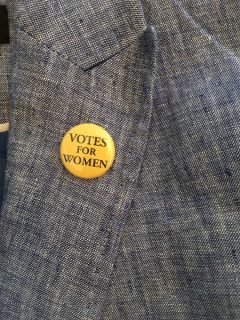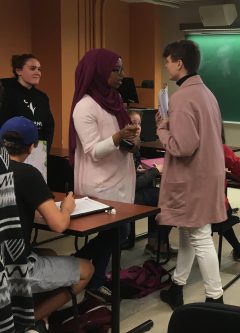 The students in Pamela Walker’s first-year seminar, The Long Civil Rights Movement, aren’t just reading about the immigrants, suffragettes, labour activists, and bohemians who made Greenwich Village, New York a hotbed of social activism in 1913, they are putting themselves in the shoes of those activists.
The students in Pamela Walker’s first-year seminar, The Long Civil Rights Movement, aren’t just reading about the immigrants, suffragettes, labour activists, and bohemians who made Greenwich Village, New York a hotbed of social activism in 1913, they are putting themselves in the shoes of those activists.
Over the course of the first semester, the students are assigned roles informed by classic texts in the history of ideas. They then participate in role-playing simulations in order to understand what inspired people to take to the street, to engage in protest, and to break laws, in an effort to transform American society. The game is part of the Reacting to the Past program.
Professor Walker explains how role-playing offers her students the opportunity to take charge of their class and to hone their public speaking, writing, and analytical skills, all while diving deeply into the tumultuous social world of 1913 New York.
Q. Why did you decide to use games as a way to animate your first-year seminar on the history of civil rights movements in the U.S.? 
Reacting to the Past was created for Columbia University’s history students and it has been adopted at universities across the United States. Many of my colleagues there were excited about how well it engages students to think, read complex historical texts, to write analytical essays and to work collaboratively and, at the same time, to play a game.
Q. Can you give an example of an activity or game that your students might complete as part of this course?
Each student is assigned an historical character. They have to read, for example, a section of Karl Marx’s Communist Manifesto and consider how their character responded to his ideas. They have to know what political ideas their character did embrace and understand how they would have responded to Marx and to write an analytical essay.
Q. Surely the course is not all fun and games for the students. What kind of work goes on behind the scenes by the students? What sorts of preparations do t hey undertake?
hey undertake?
The games require students to understand the historical context and respond to it in character. Emma Goldman tries to distribute birth control information but if she is detected by the police, she will land in jail. She must understand what was legally permitted and what opposition she faced. The student must research these facts and understand how to use them to prosper in the game. Other students have to understand the opposition to women’s suffrage and know how to respond, in an historically accurate way. Another group of students researched dance and music in 1913 and next week, they are teaching the class the foxtrot and explaining its relationship to politics at that time. The game has a winning side and those with the best research and best understanding of the historical problems will win.
Q. How have your students responded so far?
They are producing excellent work. They are working together to build their arguments and to advance their positions in the game. Classes are loud. When the women’s suffrage group was demanding the right to vote, they were on fire and outraged by the opposition they faced. I am sure those students will never forget the principle ideas of women’s suffrage.